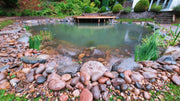
Life in a pond can be very complex, and much of it depends upon non-living elements to help keep the ecosystem healthy. The main non-living elements in ponds include water, soil, rocks, and different minerals, all of which are extremely important for the many organisms that live in these aquatic environments. These elements create not only conditions for life but also add to the general balance and functioning of the ecosystem.
· Water
Water is the simplest basic non-living thing that can be found in any pond. It forms a home for innumerable species of organisms and is the medium in which most of their lives are carried out. Water quality, including temperature, pH, and clarity, has an immediate impact on the range of organisms that can survive. Some species of fish prefer cold water, whereas others can sustain higher temperatures. Water is also a medium of transport for nutrients; it supports the growth of aquatic plants and microorganisms.
· Soil and Sediment
The soil and sediment at the bottom of a pond is the home for the whole of the pond ecosystem. The soil type will vary widely and may greatly affect nutrient availability and the type of plants that can be supported. Nutrient-rich sediments host a wide variety of plant life, which provides habitat and food for aquatic organisms. Poor nutrient sediments may restrict the growth of plants and, consequently, the overall biodiversity of the pond.
· Rocks and Substrate
ecosystem functions, such as offering structure, habitat for species, places to hide, and a location to spawn or breed. Large boulders and small rocks may offer further support of the edges from erosion and therefore help prevent excess sedimentation processes that may be contributing to poor habitats.
· Minerals
Other necessary inanimate divisions include minerals. The chemical composition of the water depends on the mineral condition, which also participates in nutrient cycling. Calcium and magnesium are some of the crucial minerals that are required by all aquatic plants and animals for their proper growth and health. They can also be used to determine the trophic status of a particular ecosystem, which can then support life in abundance.
Knowledge of what non-living things live in a pond is important because they are composed of water, soil, rocks, minerals, and organic matter that are essential in fully understanding life in the pond. Each component plays a very unique role and adds something different to the health of the pond, showcasing the connectivity of life and non-life in this thriving ecosystem.
How Non-Living Things Affect Pond Health

The health of a pond greatly relies on the quality and quantity of its non-living organisms. For instance, water quality is very significant as it not only provides a habitat but also a medium of nutrient carriage. The pH, temperature, and dissolved oxygen levels are non-living aspects that directly impact the health of pond organisms.
Equally important are the soil and substrate composition. Different types of soil will affect nutrient availability, which may consequently impact the growth of the aquatic plants. The aquatic plants serve as an important source of oxygen and habitat for various species living in the water. Besides rocks, non-living features also form an environment for organisms to hide and breed, which enhances biodiversity.
Knowing what organisms live in non-living state in a pond will also contribute to the study of the quality of the said ecosystem. By example, healthy quantity of minerals is indicative of good water, and their inadequacy-otherwise, signaling pollution or poor nutrient content of water.
Managing Non-Living Elements in Your Pond
Managing non-living organisms in the pond is quite necessary to maintain a healthy pond ecosystem. Testing of water quality should be one of the routine activities just to monitor pH, temperature, and dissolved oxygen levels of water. This may aid in early detection of impending problems, hence timely interventions which may ensure the well-being of pond inhabitants.
Additionally, proper sediment and soil management can prevent erosion and nutrient runoff. Buffer zones can be established around the pond to help minimize soil erosion and can improve water quality by filtering chemicals and other components before they enter the pond by using native vegetation.
Non-living features like rocks and sunken logs can also be maintained to keep the structural integrity for the benefit of pond organisms. These types of structures offer important habitats for fish and invertebrates, which can thrive and help balance the ecosystem as a whole.
Adding Inanimate Features to Your Pond
Inanimate features added to your pond may greatly enhance both its ecological well-being and its aesthetic value. For example, carefully positioned rocks and boulders provide both shade and shelter for fish and other aquatic organisms, while gravel beds may give the perfect sites for spawning and incubation to some fish species.
It's equally important to make different levels in the pond. The shallow areas will cultivate the growth of aquatic plants, which are highly beneficial for oxygen production and habitat formation; deeper parts create a stable environment, wherein organisms are protected from extreme temperature fluctuation, hence providing a safe haven for its residents.
Conclusion
In summary, the abiotic components of the pond, or water, soil, rocks, minerals, and organic matter, are all equally important for an ideal balance. Each of the elements in itself is very in
strumental in maintaining favorable water quality as well as conducting nutrient cycling in support of other structural elements in a number of organisms. Its interactions with each factor-especially pH, temperature, and dissolved oxygen-effectively depend on good soil management and sediment, which is usually crucial for a proper ecological balance and biodiversity level in the pond.
Carefully designed non-living features, including strategically placed rocks, multi-level designs, and natural filtration systems such as biofilters, go a long way in enhancing both environmental health and aesthetic appeal. In the end, understanding and managing these non-living features ensures a robust, balanced ecosystem that supports life and maintains the natural beauty of ponds for years to come.







